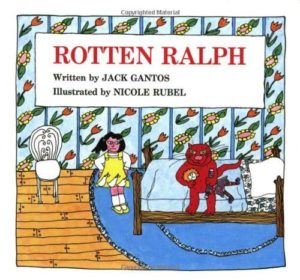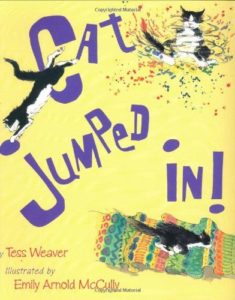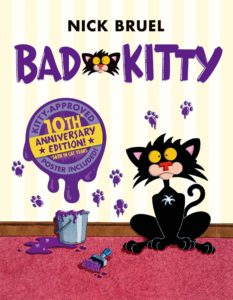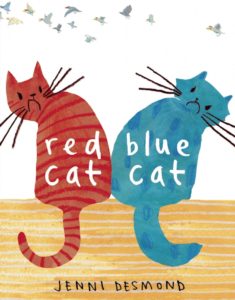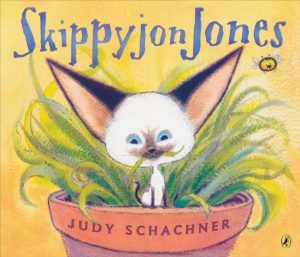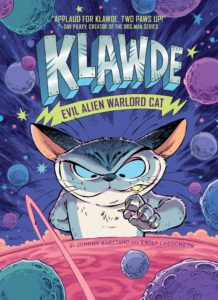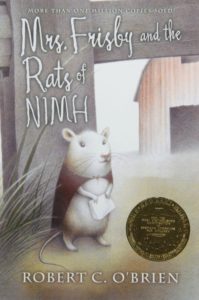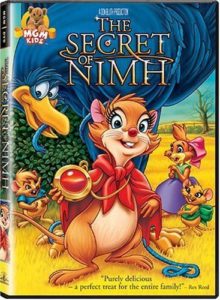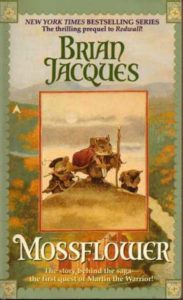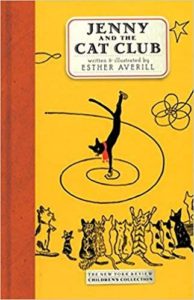
|
Esther Averill’s Jenny and the Cat Club (New York Review Children’s Collection, 2003) is a collection of stories first published in the 1940s about orphaned black cat Jenny Linsky who lives in New York City with an old sailor, the kindly Captain Tinker (who knitted Jenny her signature red scarf). In the title tale, Captain Tinker has urged Jenny to find some friends, and she longs to belong to the neighborhood Cat Club – a sort of Algonquin Round Table for cats – but she feels too timid and untalented. Ultimately, however, Jenny finds her talent – and joins the Club, bringing two fellow strays along with her. There are many Jenny stories and they’re all great. For ages 5 and up. |
| |
Make yourself a scarf just like Jenny’s! See How to Knit a Scarf for Absolute Beginners. |
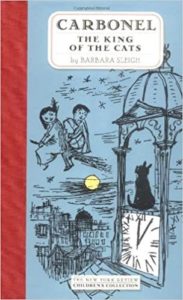
|
In Barbara Sleigh’s Carbonel: The King of Cats (New York Review Children’s Collection, 2004), originally published in 1955, Rosemary – with an eye toward cleaning houses and earning some money to help her mother – buys a broom and a cat from a peculiar old lady in the marketplace. She gets far more than she bargained for: the old lady is a witch; the broom can fly; and the cat, Carbonel, a royal feline with a high opinion of himself, needs Rosemary’s help to be liberated from a magic spell before he can regain his rightful place as King of the Cats. There are two sequels: The Kingdom of Carbonel and Carbonel and Calidor. For ages 5-12. |
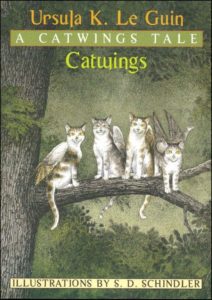
|
In Ursula LeGuin’s Catwings (Scholastic, 2003), Mrs. Jane Tabby’s four kittens are born with wings. Life is too dangerous for these odd-looking kittens in the city, so as soon as they’re old enough to fend for themselves, Mrs. Tabby sends them off to find a safe home, far from the urban slums. Roger, James, Thelma, and little Harriet cope with danger and hunger, and eventually find a loving home with children on a farm. Sequels include Catwings Return, Wonderful Alexander and the Catwings, and Jane on Her Own. For ages 7-10. |
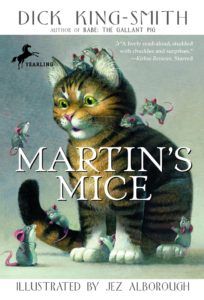
|
In Dick King-Smith’s Martin’s Mice (Yearling, 1998), Martin – a kitten – is sneered at by the other kittens for his soft-hearted affection for mice. He even manages to capture a pregnant female mouse, Drusilla, whom he keeps as a pet in a discarded bathtub in the barn. He’s devastated when Drusilla and family – who don’t enjoy being pets – escape, and only comes to understand their point of view when he’s taken away from the farm to be a pet in a city apartment. When he himself finally escapes and makes his way home again, he’s able to forge a true friendship with Drusilla and to win the respect of his father, the big tomcat Pug. For ages 7-10. |
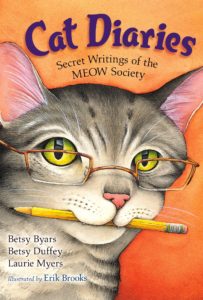
|
By Betsy Byars, Betsy Duffey, and Laurie Myers, Cat Diaries: Secret Writings of the MEOW Society (Henry Holt and Company, 2010) is a collection of eleven short stories all purporting to be from the diaries of cats. (MEOW stands for “Memories Expressed in Our Writing.”) Among the tales: “Rama, the Gypsy Cat,” “Library Cat,” “Whiskers and the Parachute,” “Miu: The Great Cat of Egypt,” and “Pirate Cat, Treasure Hunter.” There’s also a counterpart: Dog Diaries: The Secret Writings of the WOOF Society (2007). For ages 7-10. |
| |
For another take on a cat’s diary and a contrasting dog’s diary, see the Good Eats Humor Page. (Dog: “Dog food! My favorite thing!” Cat: “The only thing that keeps me going is my dream of escape.”) |
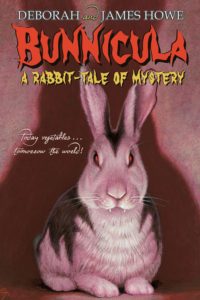
|
Chester the cat is a key player in James Howe’s Bunnicula (Atheneum Books for Young Readers, 2006) – told from the point of view of Harold, the dog – in which the Monroe family brings home a baby rabbit, found on a seat in the movie theater during a showing of Dracula. Chester – literate, sensitive, and prone to panic – becomes convinced that the bunny, now named Bunnicula, is a vampire, especially when sucked-dry white vegetables start showing up in the kitchen. Several sequels. For ages 8 and up. |
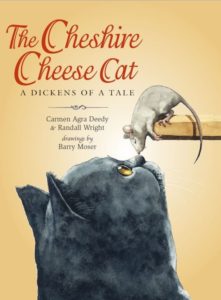
|
In Carmen Agra Deedy and Randall Wright’s The Cheshire Cheese Cat (Peachtree Publishing, 2011), Skilley, an alley cat, has found a home at the Ye Olde Cheshire Cheese, an inn frequented by Charles Dickens, who is struggling to find a first line for his new novel. (“The times were cruel. Appalling. Ghastly. I think I’ll just jump in the Thames. Or become a chimney sweep. Anything but a writer.”) Skilley – whose dreadful secret is that he prefers cheese to mice – cuts a deal with the resident mice (he leaves them in peace, they bring him cheese), and makes a particular friend of Pip, a mouse with a startlingly large vocabulary, who can read and write (with his tail). Together they manage to defeat Pinch, a vicious ginger cat, and, with some help from Queen Victoria, restore a wounded raven, Maldwyn, to his home in the Tower of London. And Pip provides the struggling Mr. Dickens with his essential first line. Clever and delightful for ages 8 and up. |
| |
See Kids Wings for assorted research links related to The Cheshire Cheese Cat, among them information on the real Olde Cheshire Cheese inn (a historic landmark in London), Charles Dickens, A Tale of Two Cities, Queen Victoria, and the ravens of the Tower. |

|
In Elizabeth Coatsworth’s Newbery-Medal-winning The Cat Who Went to Heaven (Aladdin, 2008), originally published in 1930, a poor Japanese artist is appalled when his housekeeper spends their few coins on a little cat instead of much-needed food. The cat, Good Fortune, however, lives up to its name: the artist soon receives a commission from the monks of a nearby temple to paint a picture of the Buddha’s death, with all the earth’s animals gathered around him to bid him farewell. According to Buddhist legend, the cat, who refused to pay homage to the Buddha, is forever barred from heaven – but the artist, who loves his little cat, includes a cat in the painting. The monks are furious and announce their intention to have the painting burned – but in the morning they find that a miracle has occurred. The painting has altered: now the little cat sits beside the Buddha, who is reaching out his hand to it in blessing. For ages 8 and up. |
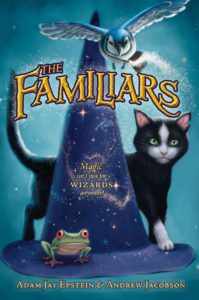
|
In Adam Jay Epstein and Andrew Jacobson’s The Familiars (HarperCollins, 2011), the first of a series, Aldwyn, an alley cat, escapes from a bounty hunter by ducking into a peculiar pet shop – one that specializes in familiars – and is purchased by Jack, an eleven-year-old wizard-in-training. In company with two other familiars – Skylar, a know-it-all bluejay, and Gilbert, a tree frog – Aldwyn must come to the rescue when Jack and two other young apprentices are kidnapped by an evil witch. For ages 8-11. |
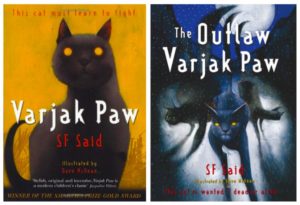
|
In SF Said’s Varjak Paw (Yearling, 2005), Varjak is a pedigreed Mesopotamian Blue, descendant of the fabled Jalal the Paw, a great hunter and fighter, who could make himself invisible and talk to dogs. Varjak and his family have lived in comfort for generations in the home of the Contessa, never venturing into the frightening Outside. Then a Gentleman moves in, with two vicious black cats, and Varjak flees to the city, looking for help. There he links up with alley cats Holly and Tam, and battles the frightening gang leaders Ginger and Sally Bones. When Tam suddenly Vanishes, he, Holly, and the dog Cludge return to the Contessa’s house to save his family, and in doing so solve the mystery of the Vanished cats as well. For ages 9-12. |
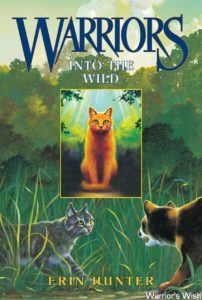
|
Erin Hunter’s Warriors series is a fantasy featuring four clans of wild forest cats, the ThunderClan, ShadowClan, RiverClan, and WindClan. In the first of the series, Into the Wild (HarperCollins, 2004), young Rusty, a house cat or “kittypet,” joins the ThunderClan, is renamed Firepaw, and begins training as an apprentice warror. A good bet for fans of Redwall. For ages 10 and up. |
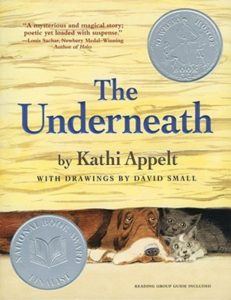
|
Kathi Appelt’s Newbery Honor book The Underneath (Atheneum Books for Young Readers, 2010) is a complex, painful, magical, and wonderful tale (told in many brief chapters) of an unlikely friendship between an abandoned pregnant calico cat and Ranger, an old hound dog chained beneath the porch of a shack in the East Texas bayou and abused by his owner, Gar Face. The adventurous kitten Puck, who leaves the safety of the Underneath, triggers a tragedy and a cascade of events involving the monstrous King Alligator (Gar Face’s white whale) and shape-shifting Grandmother, an ancient water moccasin trapped in a buried pottery jar. For ages 10 and up. |
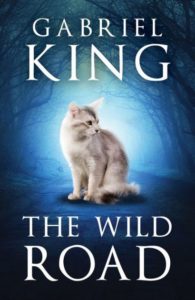
|
Gabriel King’s The Wild Road (Del Rey/Ballantine, 1998) is high fantasy for cat lovers. The hero, a kitten named Tag, is sent on a quest by the mysterious one-eyed black cat, Majicou: He must find the king and queen of cats and bring them to Tintagel in Cornwall before the spring equinox. Majicou, it turns out, is the keeper of the wild roads, ancient energy paths used by animals to travel through time and space. The villain is the evil Alchemist, who is trying to gain control of the roads, and the cat queen (Pertelot Fitzwilliam) is central to his plan. Tag is supported in his task by a raft of helpers, among them a cockney cat, Mousebreath, a magpie, One for Sorrow, and a fox, Loves a Dustbin. The story continues in The Golden Cat. For ages 12 and up. |
